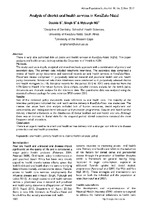| dc.contributor.author | Dookie, S. | |
| dc.contributor.author | Singh, S. | |
| dc.contributor.author | Myburgh, Neil G. | |
| dc.date.accessioned | 2017-12-13T09:58:59Z | |
| dc.date.available | 2017-12-13T09:58:59Z | |
| dc.date.issued | 2017 | |
| dc.identifier.citation | Dookie, S. et al. (2017). Analysis of district oral health services in KwaZulu-Natal. African Population Studies. 31(2): 3683-3693 | en_US |
| dc.identifier.issn | 2308-7854 | |
| dc.identifier.uri | http://dx.doi.org/10.11564/31-2-1041 | |
| dc.identifier.uri | http://hdl.handle.net/10566/3327 | |
| dc.description.abstract | There is very little published data on public oral health services in KwaZulu-Natal (KZN). This paper analyzes oral health service delivery within the Department of Health in KZN.
METHODS
The study used an in-depth, analytical and mixed methods approach with a combination of primary and secondary data. The primary data included telephonic interviews. The secondary data comprised a review of health policy documents and statistical records on oral health services in KwaZulu-Natal. Document review comprised 11 purposively selected national and provincial health and oral health policy documents. Structured telephonic interviews were conducted with purposively selected district oral health managers (n=10). Statistical records for the period 2010 to 2012 were obtained from the KZN District Health Information System. Data analysis included content analysis for the health policy documents and thematic analysis for the interview data. The quantitative data was analyzed using the statistical software package for social sciences SPSS version 23.0.
RESULTS
Five of the reviewed policy documents made reference to oral health care. The majority of the interview participants indicated that oral health service delivery in KwaZulu-Natal was inadequate. The themes that arose from data analysis included lack of human resources, dental equipment and consumables, and inadequate dental education and promotion programmes. Data on oral health service delivery indicated imbalances in the distribution of dental facilities and oral health workers. Although there was an increase in dental visits for the required period, dental extractions remained the most frequent clinical procedure.
CONCLUSION
There is an urgent need to re-orient oral health service delivery with a stronger commitment to disease prevention and oral health promotion. | en_US |
| dc.language.iso | en | en_US |
| dc.publisher | SUN journals | en_US |
| dc.rights | This work is licensed under a Creative Commons Attribution-NonCommercial-ShareAlike 4.0 International License. | |
| dc.subject | Oral health | en_US |
| dc.subject | Primary health care | en_US |
| dc.subject | District health services | en_US |
| dc.subject | Policy | en_US |
| dc.title | Analysis of district oral health services in KwaZulu-Natal | en_US |
| dc.type | Article | en_US |
| dc.privacy.showsubmitter | FALSE | |
| dc.status.ispeerreviewed | TRUE | |

